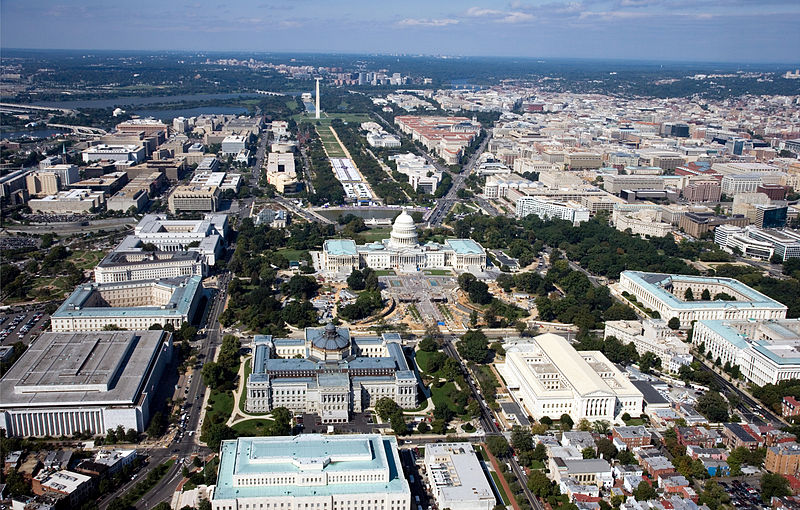District of Columbia Establishes New River-Protecting Stormwater Management Standards
Note to Reader:
In July 2013, the District of Columbia Depart of Environment (DDOE) released the 2013 Rule on Stormwater Management and Soil Erosion and Sediment Control. DDOE also released the 2013 Stormwater Management Guidebook, which provides technical guidance on how to comply with the rule.
The new Stormwater Rule require most new developments to retain the first 1.2″ of rainfall on site. The Guidebook includes state-of-the-science specifications on thirteen different stormwater best management practices. The specifications include design details, calculation procedures, and construction guidance for each BMP, as well as spreadsheet tools that aid designers and plan reviewers in determining compliance with the new rules.

Aerial view (looking west) of Capitol Hill and the National Mall in Washington, District of Columbia (Photo Credit: Wikimedia Commons)
District Releases New Stormwater Management Rule and Guidebook
The District Department of the Environment (DDOE) finalized a new regulatory framework for stormwater management by large development sites in the District of Columbia. The new regulations were published in the DC Register on Friday, July 19, 2013.
Capture Rain Where It Falls
The new framework includes stormwater retention performance standards that will dramatically reduce stormwater runoff’s harmful impacts to the Anacostia and Potomac Rivers, Rock Creek, and their tributaries. It also includes an innovative Stormwater Retention Credit (SRC) trading program, which is the first of its kind in the nation and has the potential to increase the new standards’ benefit to District waterbodies while reducing the cost of compliance and providing other sustainability benefits.
“This new regulatory framework will transform the District’s impervious areas into a more river-friendly landscape,” said DDOE Director Keith A. Anderson. “It is a critical  step toward making District waterbodies more usable and attractive for residents, businesses, and visitors. It will also go far in meeting Mayor Gray’s Sustainable DC goal of making 100% of District waterbodies fishable and swimmable by 2032.”
step toward making District waterbodies more usable and attractive for residents, businesses, and visitors. It will also go far in meeting Mayor Gray’s Sustainable DC goal of making 100% of District waterbodies fishable and swimmable by 2032.”
Under the rule, large construction sites that trigger the requirements will install green roofs, rain gardens, permeable pavement, and other green infrastructure practices to reduce stormwater runoff. Stormwater runoff erodes District stream banks and carries trash, oil, pet waste, and other pollutants into District waterbodies.
Specifically, sites that disturb 5,000 square feet (SF) or more of land will be required to retain the stormwater from a 1.2 inch storm, as required by the Municipal Separate Storm Sewer System (MS4) Permit issued to the District by the Environmental Protection Agency. The MS4 Permit also requires the District to establish a lesser retention standard for major substantial improvement projects, which are renovations of existing structures that have a combined 5,000 SF footprint and for which the project cost exceeds 50% of the pre-project value of the structure. These major substantial improvement projects are required to retain the volume from a 0.8 inch storm.
Stormwater Retention Credit Trading Program
To help regulated sites meet these requirements and achieve voluntary stormwater retrofits on unregulated properties, the rule allows regulated sites to achieve 50% of their required stormwater retention volume offsite, using privately tradable SRCs or by paying an in-lieu fee to DDOE. DDOE expects SRCs to be a more cost-effective option for regulated sites.
Approximately 43% of the District’s land area is composed of rooftops, parking lots, and other impervious surfaces and only 1% of the District’s land area will trigger these regulations in a typical year. Therefore, property owners who do not trigger the regulations will have tremendous opportunity to voluntarily retrofit their properties in order to generate SRCs for sale.
By creating a market for stormwater retrofits on properties that otherwise would not be retrofitted in the near future, SRC trading offers a range of impressive sustainability benefits. In addition to having the potential to reduce compliance costs and maximize flexibility for regulated sites, SRC trading can result in a significant increase in total stormwater retention in the District and provide other benefits to District waterbodies, compared to strictly requiring regulated sites to achieve retention on site. By increasing the installation of green infrastructure, SRC trading can also provide other sustainability benefits, including new job opportunities, improved community health, and attractive new green spaces across the city.
To Learn More:
The final rule, the final SWMG, and related resources are available at http://ddoe.dc.gov/swregs.

